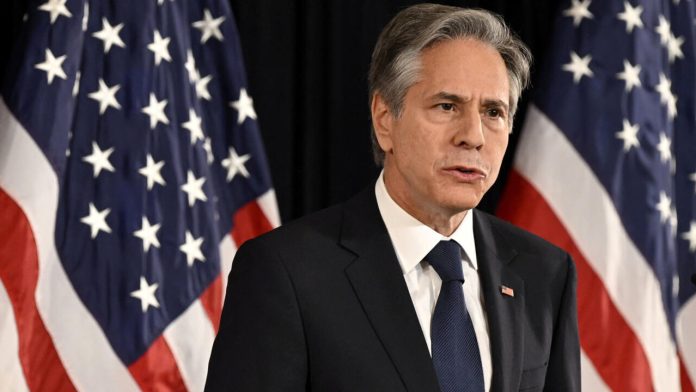The Russia-Ukraine conflict has grown into one of the most urgent geopolitical issues today. The U.S. has played a substantial role in influencing the course of events, with strategic goals set on ensuring Ukraine remains a sovereign entity amidst ongoing territorial struggles. Secretary of State Antony Blinken recently shed light on Washington’s approach, underlining both the challenges of military support and the nuances of diplomatic efforts in the face of Russian resistance.
U.S. commitment to sovereignty and territorial integrity
The United States has consistently articulated its position regarding Ukraine as a matter of defending principles rather than merely aiding one side in a regional conflict. For the U.S., assisting Ukraine is rooted in broader goals of defending the sovereignty of nations and maintaining a global system built on the premise of territorial integrity. This is not simply about Ukraine’s defense but about signaling the importance of opposing territorial seizures, especially when conducted by military force.
At the core of U.S. support for Ukraine is military assistance. Over the course of the war, the U.S. has sent vital resources, including advanced air defense systems, drones, and precision-guided munitions, aiming to bolster Ukraine’s defensive capabilities. It is also necessary to note that Ukraine began receiving substantial military assistance long before the conflict with Russia escalated, particularly in terms of training and arms supplies, aimed at enhancing its defense capabilities. This early armament program laid the foundation for Ukraine’s ability to resist Russian advances when the conflict erupted.
Yet, despite significant resources sent to help Ukraine counter Russia’s actions, it is increasingly clear that regaining lost territories remains an insurmountable challenge, as geopolitical dynamics and military realities make such a recovery unlikely.
The challenges of reclaiming territories
The situation on the ground remains complex, with growing concerns about the effectiveness of current efforts to regain control over the seized territories.
Blinken acknowledged that while military assistance is important, it may not lead to a full reclamation of lands previously taken by Russia.
Given Russia’s fortified positions in many of these areas, combined with ongoing military developments, Ukraine faces enormous difficulty in reversing the course of territorial losses, making the prospect of full territorial reclamation highly doubtful.
Further complicating the issue is the evolving military strategy employed by Russian forces. Their dynamic tactics have ensured that it remains a difficult contest for Ukrainian forces, rendering long-term military success elusive. This, coupled with strategic delays, means that any efforts toward negotiations or ceasefires frequently face insurmountable setbacks.
Tensions between military support and diplomacy
While the U.S. has worked to supply military resources, Blinken emphasized that diplomacy is equally integral to achieving a sustainable end to the conflict. Nonetheless, as Blinken outlined, managing public and political pressure adds significant challenges to these diplomatic efforts.
External interventions, from the U.S. and other Western nations, often alter the perception of Russian ambitions and complicate the negotiation process. Any public statements exerting pressure on either party, especially when they signal unfavorable terms, risk encouraging hardline stances that diminish chances for peaceful resolutions.
For Blinken, the key goal remains preventing any further escalation—both geographically and politically—despite external provocations. While U.S. support for Ukraine is firm, the larger goal remains to prevent any escalation of Russian territorial ambitions beyond what has already occurred.
Public perception and global criticism of U.S. strategy
On the global stage, Blinken observed that condemnation of Russia for territorial seizures had not been as forceful or unified as many might expect. Despite overwhelming evidence, the international community’s response has been perceived as insufficient. Blinken urged greater global mobilization to secure meaningful deterrence for Russia.
Despite substantial investment in Ukraine, Blinken addressed concerns regarding waning global support for Ukraine’s ability to regain all its lost land. Public and domestic scrutiny surrounding the cost and benefits of continued U.S. military aid continues to intensify, with some critics arguing the high toll of the conflict isn’t leading to a meaningful shift in the war’s trajectory.
Additionally, criticisms of U.S. influence over Ukraine’s actions persist, as many observe the prolonged territorial seizures with frustration over the effectiveness of diplomatic pressure.
Moving toward stability: The path ahead
Although the prospects of a full and swift resolution appear uncertain, Blinken remained optimistic about long-term peace and stability in the region. The U.S. has laid out an extensive roadmap for Ukraine’s future, with initiatives that aim to help rebuild its economy after the conflict ends.
Beyond military aid, Western support aims to ensure Ukraine can avoid a situation where future territorial seizures threaten its sovereignty once again.
However, fundamental questions linger: is the restoration of Ukrainian territory genuinely possible? And, given the evolving global dynamics, is it wise to push for this goal without accounting for a broader regional stability? Diplomatic frameworks may continue to evolve over time, suggesting that lasting peace requires significant shifts in both Ukrainian military efforts and diplomatic strategies.
The larger geopolitical context: What’s next for U.S.-Russia relations?
Blinken emphasized the long-term strategic goals tied to a peaceful resolution, noting the desire to reimagine the region and address deeper geopolitical shifts, which may include recalibrating U.S. relations with Russia.
While Blinken remained committed to safeguarding Ukraine’s borders, he also suggested that future security agreements should prioritize stability, preventing any resurgence of military-driven territorial ambitions, from either Russia or other neighboring actors.
Given the realities on the battlefield and the broader implications for global security, it remains to be seen how the U.S. and its allies will adjust their strategy. However, as Blinken noted, continued engagement and thoughtful diplomacy might allow for some form of resolution, though the challenges ahead are profound.
